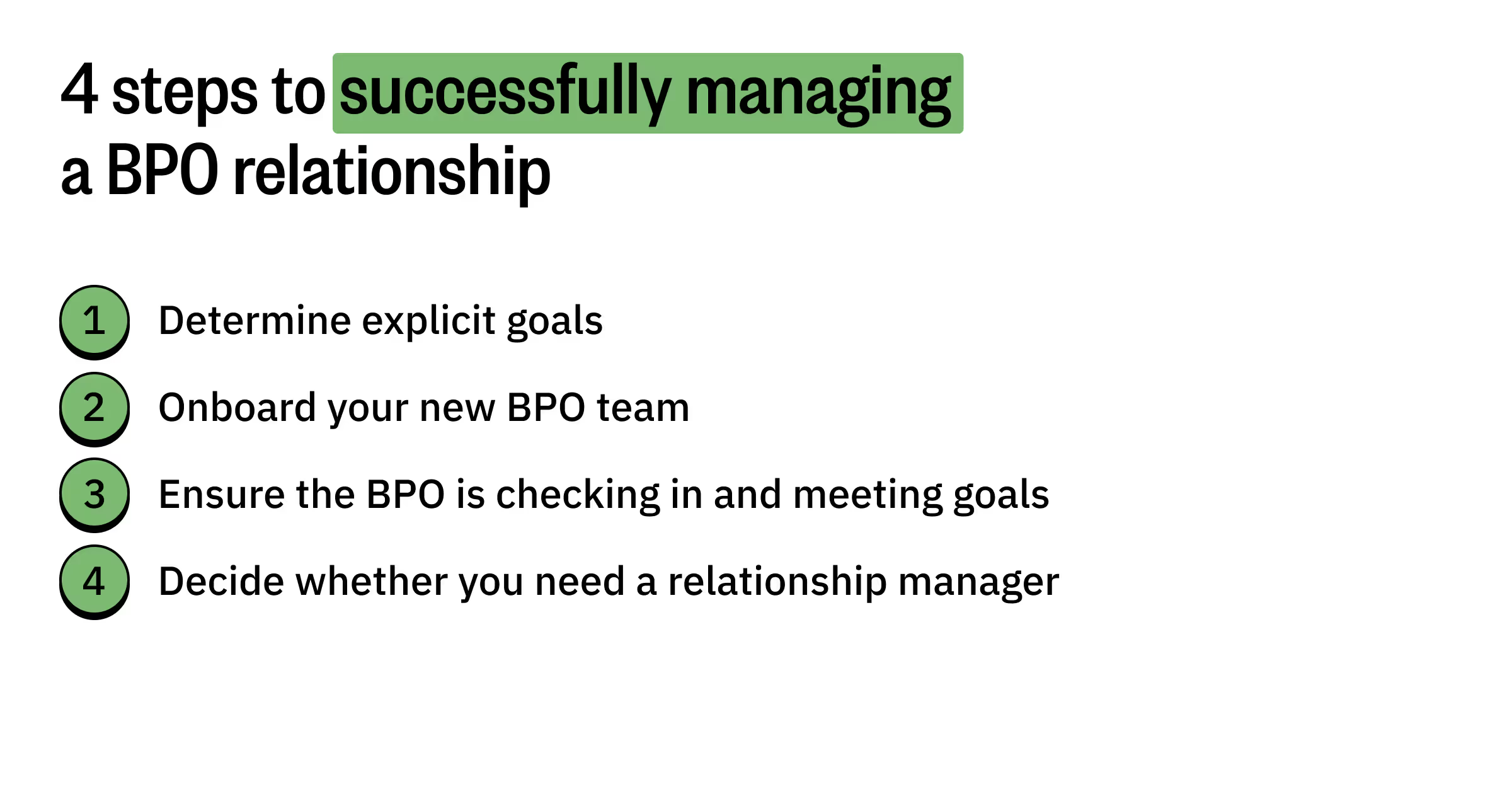Customer support outsourcing for pros: How to achieve effective BPO management

DIYers abound in the customer support space — just not the remodel-your-own-kitchen type.👷♀️ In fact, you’ve probably personally rolled up your sleeves numerous times in just the past few weeks to help out your team. Your agents have undoubtedly done the same to make sure customers are getting the help they need.
While everyone appreciates a team member who’s always willing to go the extra mile to help out — that’s actually the thinking behind Assembled’s “Get on the plane” value — there’s a limit to how much you and your team members can take on. At a certain point, you need to find a sustainable way to grow while ensuring quality remains high.
For many support teams, the solution to maintaining this balance is enlisting business process outsourcing (BPO). That said, it has to be done the right way. Customer support outsourcing isn’t something to be taken lightly. Here’s how to get ready for the road ahead.👇
Determine whether you want to pursue customer support outsourcing
If you’re new to BPO, think of it as a way to enlist external experts to help refine your customer support processes. It can enhance efficiency, reduce costs, and support the customer experience. And you’re hardly alone if you’re just beginning to consider this approach for the first time. According to research from Statista, the global customer care BPO market size is projected to reach $30.4 billion by 2027. Yes, that’s just the share of the market dedicated to customer support.
BPO has grown in the customer support space for a variety of reasons. Zendesk outlines a number of benefits that are worth considering:
⭐️ Enhances the ability to adjust staffing for busy seasons and after-hours support
⭐️ Provides access to specialized expertise
⭐️ Enables for scaling without diverting attention from other priorities
⭐️ Reduces operational costs
The potential for cost savings is, for many organizations, particularly appealing. Deloitte’s Global Outsourcing Survey 2020 reveals that 70% of executives say that cost reduction is their primary reason for outsourcing.

However, the sheer popularity of customer support outsourcing doesn’t necessarily mean it’s the right solution for your organization. Before you pursue BPO vendors, the actual organizations that provide outsourced customer support, make sure it’s the right tactic for your support department. That means assessing where your team is now and what it will take to achieve objectives in the future. For small teams with a handful of agents, it might actually be better to scale the department fully in-house.
If, on the other hand, your team is already outgrowing HQ and you’re working toward lofty goals, customer support outsourcing is likely a good option. And bear in mind that you can take a hybrid approach, meaning your in-house agents handle some requests while your BPO agents handle others.
Lastly, think about what level of involvement you’re willing to commit. In BPO relationships, you can be as hands-on or hands-off as you want to be. You just have to make sure you choose the right BPO vendor and explicitly state expectations in the contract.
Evaluate options for outsourced customer support
Once you’ve determined that you’re interested in moving forward with BPO, you’ll need to start comparing different vendors. While this can seem intimidating, it doesn’t have to be. Breaking it into two distinct phases can help, and the first is all about quickly arriving at a shortened list of customer support outsourcing options.
Ask some high-level questions
There are certainly many BPO vendors to choose from, but you might be surprised at how quickly you can rule out a lot of those contenders by doing your research.
Start by asking some key questions as you look into different BPO vendors. You can even find some of this information — location, company size, rates, and areas of specialty — just by looking through vendors’ websites. You might even compare options using the reviews available on websites like G2 and TrustRadius. That said, you’ll want to contact individual vendors to uncover answers that aren’t as readily apparent.
Zendesk recommends learning more about the vendor’s familiarity with remote operations, whether they’re able to overcome technical issues, and how they onboard and train new agents. Kustomer also recommends seeking a BPO vendor whose culture and values match those of your organization.
Effectively, start by asking some basic questions that can help you identify whether it’s even worth putting a particular BPO company into the running. Here are a few questions you might consider:
- How familiar are your agents with the types of products and services we provide?
- What portion of your operation is dedicated to customer support?
- Do you have a business continuity plan and, if so, what does it entail?
- What types of tools does your team rely on?
- How do you ensure agents feel supported and motivated?
Reach out to BPO vendors with an RFP
Only after you’ve done your due diligence, you can move into the request for proposal (RFP) phase. Drafting an RFP, collecting responses, and comparing vendors is a time- and labor-intensive process, so you want to have a pretty short list of frontrunners selected first.
When it comes to creating an RFP, it’s often helpful to familiarize yourself with the basic structure. This template from HubSpot is a good starting point. However, there are some limitations given it’s designed for relatively small-scale and short-term projects. There are many more specific details you’ll want to include within an RFP for potential customer support outsourcing vendors.
So, what does your RFP need to include? Here’s what the experts at Outsource Consultants suggest:
- Company overview — provide background information on your organization, including the products or services you offer, how the company started, and your key differentiators
- Vision and goals — clearly outline your overarching objectives, current challenges you’re facing, and why you’re choosing to outsource
- Overview of current support program — explain support team goals, existing processes, and key metrics used to evaluate success
- Timeline for training — describe the training program in detail and outline the timeframe from start to finish
- Estimated contact volumes — outline contact volume at daily, weekly, and monthly levels and break them down by channel
- Ideal agent profile — describe the persona of an agent that provides optimal service and performance
- Vendor expectations — provide an opportunity for BPO vendors to make their case and include information about KPIs, the company, customer support experience, training protocols, references, and more
Importantly, the RFP must indicate your budget. Remember that a BPO relationship is a partnership. A vendor needs to know that your quality expectations align with what you’re offering for their services.
Your RFP should also include an overview that clearly displays the submission deadline, a point of contact for questions, and next steps in the event of selection. If it sounds like a lot of work, that’s because it is. But doing the legwork now will pay off in spades. The Deloitte survey actually reveals that the top lesson executives learned related to BPO is that more time needs to be spent on the RFP and vendor selection process.
Once responses roll in, take your time reviewing each one. You’ll then identify your top choice and begin the negotiation process, which should involve members from your legal, sales, finance, and leadership teams. Together, you can discuss the finer details of costs and contract terms. While involving other leaders across the organization is essential, make sure your voice is heard. It’s important to ensure you don’t make the decision solely on cost because maintaining a high-quality support department is essential in the long term.
Once both parties have come to an agreement, all that’s left to do before getting started is to sign on the dotted line.
How to ensure effective BPO management
After you’ve selected the right BPO vendor for you, it’s time to start planning for the implementation and maintenance phase. Following the below steps will help to ensure day 1 goes just as smoothly as day 1,001.

Determine explicit goals
When you think about it, deciding to work with a BPO is all about meeting organizational objectives. You should collaborate with stakeholders across your company to make sure that you set support department goals that align with those overarching objectives. And don’t be afraid to get pretty specific — having clear benchmarks will be incredibly beneficial for the BPO vendor.
So, what types of goals should you focus on? Most of them will be based on the customer service metrics you already track each and every day. But not all of them. Here’s a run-down of expectations you might provide:
- Serve an average monthly contact volume of 3,000
- Maintain an average handle time of 4 minutes and 30 seconds
- Meet an average speed of answer of 25 seconds
- Preserve a Net Promotor Score of 80%
- Ensure agents have a minimum of 2 years of experience
- Require agents to complete 4 hours of dedicated phone training
As you can see, it’s wise to set expectations related to agents’ training and experience. Doing so will help to maintain the quality standards your team has become known for.
Onboard your new BPO team
After you’ve identified all relevant goals for your BPO vendor, it’s time to begin the onboarding process. This will entail sharing those specific goals, but it also involves training, setting up software required for the job, sharing upcoming product releases, and laying out timelines.
If you’re using a WFM tool and would like your BPO to be incorporated into that platform, this adds another layer of complexity. Thankfully, Assembled makes this process much easier. There is a bit of upfront legwork, but don’t give up now because the payoff is immense. You’ll always have full visibility into performance across channels.
It’s also in your best interest to provide as many resources to your BPO agents as possible. Even with a thorough training program, there’s always a chance that a customer will catch an agent off-guard with an unexpected question. Consider leveraging a knowledge base, an internal forum, or even additional training sessions that address common issues.
Ensure the BPO is checking in and meeting goals
After you go live with customer support outsourcing, you’ll want to keep tabs on how things are going. Is the BPO meeting goals? Are there unanticipated challenges that are affecting SLAs?
Even if you’re using a WFM tool that provides you with a good picture of how BPO agents are performing, make sure to host frequent check-ins. Why? Because metrics alone don’t always provide the full picture. Having regular conversations gives the BPO vendor a chance to explain details that might not be readily apparent.
For example, maybe CSAT scores suddenly dipped. Your gut reaction might be that agents simply aren’t performing up to your standard. But upon closer investigation, you might discover that the true source of customer frustration is actually related to a glitch in a new product. In this scenario, addressing the issue requires circling back to your own organization.
How frequently you should meet with your BPO representative really depends on a number of factors, including the size of the operation, how performance is faring, and so on. Just make sure that you establish some sort of regular meeting cadence.
Decide whether you need a relationship manager
You put in the hard work of researching vendors, comparing options, making a selection, and onboarding a BPO partner. Now, it’s important to ask yourself whether you should be the one to continue managing the relationship.
Maybe your BPO vendor is primarily handling after-hours calls within the U.S. related to a specific product line. In this case, you probably have the capacity to continue overseeing the operation. But if you’re looking at a customer support function that’s available 24x7, serves customers around the globe, employs 2,000 agents, and supports nearly every channel of engagement — 😅 — you’re going to need some help in the form of a BPO manager.
A BPO manager is someone who explicitly manages BPO relationships. They ensure the vendor is adhering to the contract, meeting metrics, and keeping costs in check. Going forward, they’ll also be responsible for leading the RFP and negotiation processes.
Deciding whether it’s the right time to bring on someone for this role can be tricky, so take a step back and think about where your organization is headed. If you’re working toward aggressive goals that will require continued support team growth, it could be a smart move. Next comes building your case for hiring this person to leadership, which should come fairly easily if you incorporate forecasts that show the true ROI they can expect.
Manage change, growth, and challenges with confidence
Customer support outsourcing is complex. That doesn’t mean it isn’t worth it (it really, really is), but it does mean that successful BPO management requires a lot of research, planning, and strategic implementation — this isn’t the type of project you should expect to DIY.
Instead, think of yourself as the contractor overseeing the remodeling operation. While it can be daunting to take on such an important leadership role, you’re not alone in navigating changes as your rate of growth continues to increase. Leaders at all different types of organizations are having to solve increasingly large, complex challenges.
Eager to learn how they’ve managed to succeed? Tune into the first season of Supportive, a podcast by Assembled and ElevateCX.





